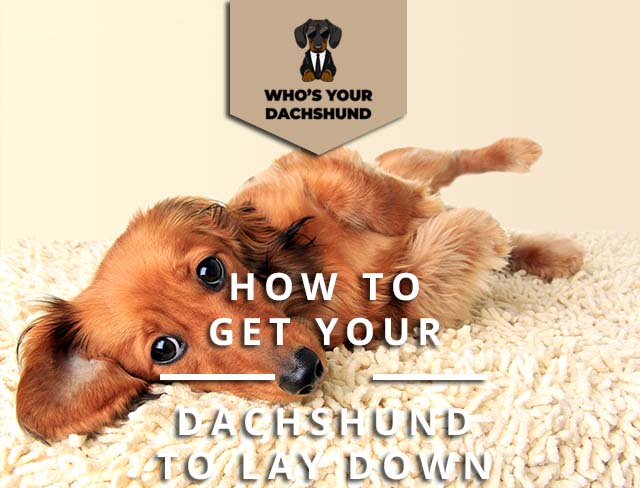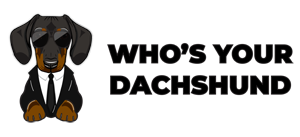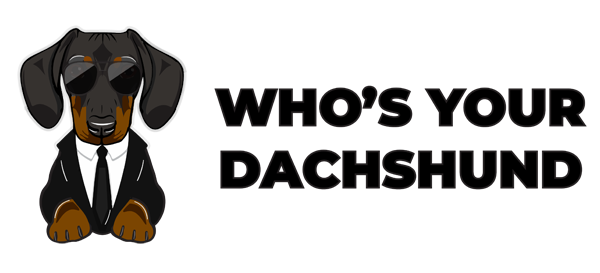
The first step in teaching your Dachshund to lay down is to get them used to the command. Use it often when your pup is at your feet. The next step is to have them lie down at your feet. When they begin to do this, you can reward them with praise or a treat.
The third step is to have the Dachshund lie down at your feet when you tell it. That can be a challenge for many Dachshund owners. The way to do this is by being patient and consistent with your commands. When you command your dog to lie down, don’t get frustrated if he’s not doing it right away. A well-trained Dachshund will lay down at your feet without being told to do so.
Once your Dachshund lies down at your feet, then you can begin to reward it with praise and treats, or both if you choose. Once your Dachshund is used to getting rewarded for laying down and is getting all the benefits of being right at its owner’s feet, you can begin to make him do this outside of the house. One can take three steps for those interested in training your Dachshund to lay down.
If your dog gives you a funny look when you take out the treat, don’t worry; most Dachshunds are smart enough to know that if they want to get their faces in front of the camera, all they have to do is sit and pose.
Basic training commands- Sit, Down, Stand.
Sit:
Place your dog in the sit position by pushing up from your hips and gently guiding their butt towards the floor. Please encourage them to stay in this position for 10 seconds before releasing it with a treat or toy.
Down:
Place your dog into the sit position and pat their chest a few times until they lay down. Always release food after 10 seconds.
Stand:
Scratch or rub your dog behind the ears until they stand up.
Volume Control:
Teach your Dachshund to be quiet by covering their mouth with a treat. By covering its mouth, you force your dog to stop barking and pay attention to you for 10 seconds before letting them do anything else.
Give Them a Treat
An excellent way to reward a pet is to give them a treat. This dog food reward can help the animal associate the desired behavior with something positive in their life. It helps strengthen the bond that you have with your pet.
Be Patient
Being patient with your dog is very important. Be patient and give your Dachshund time to learn how to do what you want it to do. Never get frustrated or mad at your dog. Stay calm and gentle while training your pup what you want it to do. You can try showing the dog one more time if it does not seem to get it but never push your dog too hard.
Additional Dachshund training
Dachshund training is based on the principle that Dachshund dogs are what they are and that the only way to make them into something else is to change them. The all-too-human owner’s task is to do something about what they are. One cannot make a “good” dog into an “accessory dog.” It isn’t possible. On the contrary: it can be a full-time income for some people. The frequency with which you will need to train your puppy will depend on the dog and its personality. Most Dachshunds are easily trained. It just depends on how much time and effort you want to train the dog. The more exercise, attention, and training that you give your dog, the better behaved it will be in general. Remember that not all dogs are quick learners or fast learners, so some may take longer than others to learn what they need to know.
Obedience training
Obedience training is vital for Dachshunds but not something that should take priority over primary care and exercise. They are brilliant dogs who excel at learning, so obedience training is a good idea if you want your dog to learn and behave well. However, be sure to teach the dog some basic commands that they can perform with minimal training, like sit, down, and come before you begin your obedience training sessions.
Why Do Dachshunds Lay On Their Backs?
Dachshunds are short-legged, long-bodied dogs bred to hunt badgers and other burrowing animals. They are intelligent but willful and can become very bored with their surroundings. Some Dachshunds have been known to display a compulsive behavior of lying on their backs with legs stretched out to the side. It is called “The Dachshund Laying Down Syndrome” (DLS).
Many people are under the impression that Dachshunds are content after lying down; however, this is not true. They often itch or rub against items in the vicinity, further irritating themselves. Untrained Dachshunds that do not have regular grooming can become covered in fleas and lice.
Several factors cause DLS. The primary reason behind the excessive behavior is boredom. When a Dachshund becomes tired of playing or being active, the dog will often lay down in areas that make him itchy and uncomfortable. That can cause more discomfort, which leads to even more scratching and biting at the affected area.
Another reason that DLS occurs is due to anesthesia or injury to the spinal cord. In some dogs, a part of the dog’s brain called the irritability center can be stimulated by anesthesia. It leads to restlessness and rubbing against things.
Dachshunds that live in homes away from children may also exhibit DLS due to separation anxiety. The constant noise outside their house can make the dog feel anxious and uncomfortable. When Dachshunds are alone in the home, they will often lie on their backs to soothe themselves.
What Causes Seizures in Dachshunds?
A seizure causes Dachshunds to lay down as they are unable to move. They can usually walk or stand, but they control their head and neck. They will typically shake while having a seizure.
The leading cause of seizures in Dachshunds is idiopathic epilepsy, which means that the reason for the seizure is unknown. The disease can be attributed to genetics as many Dachshunds can suffer from this health problem. The pain from the seizures can be so great that it is difficult to stand up afterward. Dachshunds suffering from idiopathic epilepsy are often treated with phenobarbital, a synthetic drug that controls epileptic seizures.
Some researchers believe that common diseases such as epilepsy or other causes may trigger seizures in some Dachshunds. These diseases can include inflammatory bowel disease or hypothyroidism, affecting the nervous system and cause them to have a seizure.
Interacting With Your Dachshund
Interacting with your doxie has many benefits. For starters, it improves your relationship with your doxie. Interacting one-on-one is an excellent way to bond with each other and learn about one another. It’s easy to miss a lot of communication with each other in public, so this is an excellent opportunity to develop an intimate relationship. Interacting often also helps your doxie feel more comfortable around new people and places, which is vital as she grows up.
When to start basic training Commands for a miniature Dachshund?
The miniature Dachshund is a small dog often used as a companion. Dachshunds are very intelligent and easy to train, so if you’re looking for something to keep your dog occupied, this may be the right dog for you.
Commands for a miniature Dachshund will form the foundation of your relationship with your pup. You can work on commands every day as a part of your routine or only occasionally, depending on how active you are that particular week. The more you train, the more training time you spend together and increasing the training time will only strengthen your bond with your pup.
Are Dachshunds Easy to Train?
Dachshunds are one of the most intelligent breeds of dogs, which means they’re easy to train. These dogs will have a strong desire to please their humans, so they’ll try their best every day to please their master. Every dog will try to perform a command he’s been given.
The Dachshund is a perfect breed of dogs developed in Germany to hunt badgers and other small games. They have a ferocious appearance with their short legs, long body, and bushy tail. These dogs are intelligent and trainable, and they enjoy the companionship of a family. They are not great guard dogs, and they usually do okay being left alone, provided they are kept in an area secured by a baby gate. We will offer you options to consider when choosing the accessible training commands for your Dachshund.
Things to prepare for your Dachshund tricks:
- Get a mat to lay on the ground when you practice your tricks. If you don’t have one, try slipping an old towel under the carpet so it won’t move around. That way, you can use it as a tool.
Note: Make sure you hide the mat away from your dog so they don’t lay on it all the time and get bored.
- Get a treat bag or a bucket full of treats for when your dog gets it right.
- A clicker so you can mark when they get it right.
- A leash in case your dog tries to run away or gets too excited.
If you have carpet, put some pieces of the puzzle under it, so when your dog goes to the bathroom and toilet on the carpet, they will get confused and think he/she has done something wrong because there is a puzzle piece on his/her paws. When you reward your dog for going to the toilet on the carpet, it will confuse them even more because that is what they have wanted to do.
- Have a long leash, and keep it handy when your dog gets too excited.
- Have your puppy stand in front of you in a sit-stay position. Usually, it will be about 2 feet away, but they may be a little closer or farther depending on their size.
- Sometimes, you may need to use a clicker and treats to get your dog used to the smell of it. Don’t forget always to be positive and calm.
- Start with simple tricks like rolling over, shaking hands, lying down on their side, and working your way up from there.
- If they don’t get it right away, try again later, or next time you practice the trick. It will eventually get it if your pup keeps trying.
- If you get frustrated, watch the dog and see what he/she is doing. Be patient and positive.
- Always reward your dog for trying even if you don’t get it right away!
After you have completed all these steps, please take a break from practicing the trick to give your dog time to consider anything they have done incorrectly or what needs to be practiced more.
- Keep going back to the mat until you get it right.
If you are working on a trick that requires several steps and changes in position (like rolling over, for example), repeat the steps upwards of 20 times and then put the puzzle under the carpet until next time.
- Once they get it right, start having them try it without the treats.
You can use a treat to tell your dog he/she did something right, or you can get creative and tell them what you like about what they do. For example, if you want your dog to roll over, don’t just say “roll over” or “give me 5”; give them a great big hug and say “good boy!”
- Put the puzzle on a mat or carpet floor. If you have one, put the mat in front of your dog instead of under it so he/she won’t get confused and think that doing what they are doing on the mat is what they are supposed to do. Get a treat if your dog gets it right.
- Start again with your Dachshund laying down, but once you get accustomed to making the dog lay down, have your dog do it every time you say “yes.” If your dog isn’t getting it right the first time, have him/her do it again.
- Once your dog gets it right, start saying “no” every time he/she does something that wasn’t the trick you wanted him/her to do. Start with straightforward Dachshund tricks, like rolling over and shaking hands, and eventually work up to more complicated ones with many steps and positions (like laying down).

